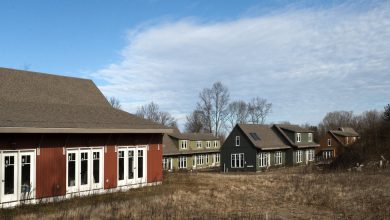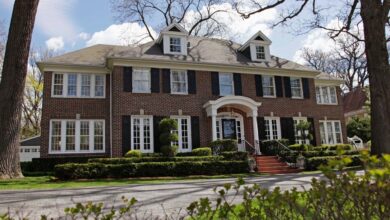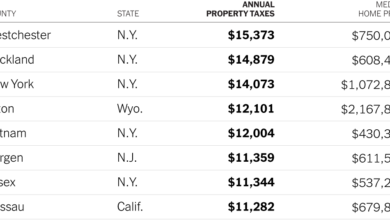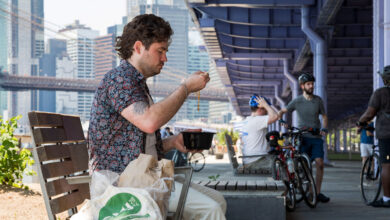From 1880s Brooklyn, the Weir Greenhouse Returns
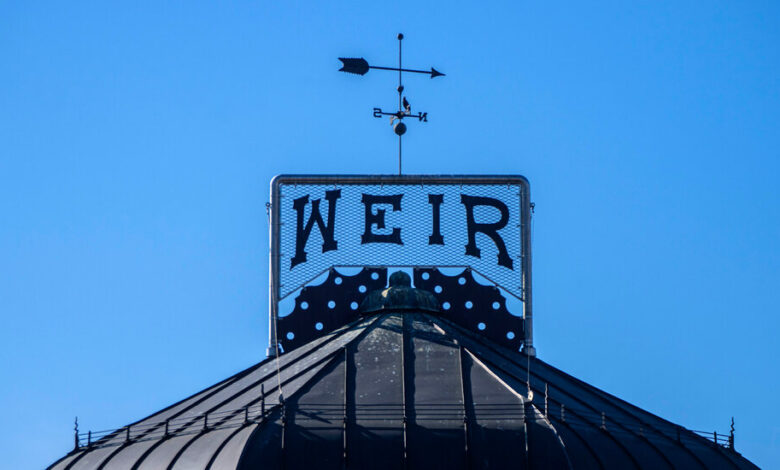
[ad_1]
New Yorkers are lucky that the exuberantly domed 1880 Weir Greenhouse in Brooklyn, the last known commercial Victorian conservatory in the city, is still around to marvel at.
The little greenhouse, on the west side of Fifth Avenue at 25th Street, looks like a retro spaceship of copper and glass that has just touched down from Victorian Gotham. If you like time travel, this is the place for you. The structure stands across the avenue from the double-arched entry gate of Green-Wood Cemetery, a transporting 1865 Gothic Revival confection of elaborately carved brownstone.
But good bones and landmark status do not guarantee longevity, and that was especially true with the conservatory.
By 2011, vandals and a century-plus of weather had rendered the fragile greenhouse a virtual ruin. Many of its badly rotting ground-floor window frames had been kicked in by marauding thieves. The brick wall at its base was crumbling. Leaking and missing window panes abounded, with repair estimates topping $1 million.
Although the hothouse was a city landmark, it was at risk of presiding over its own funeral. But in 2012, Green-Wood Cemetery swooped in to rescue it, buying the decaying treasure for $1.63 million from McGovern Florists, a flower-selling family with deep Brooklyn roots that had owned the place for 41 years.
By this July, workers are expected to put the finishing touches on an arduous, eight-and-a-half year reconstruction of the greenhouse, which is to be the gleaming jewel at the center of a planned education and welcome center for the cemetery. A Green-Wood spokesman estimated that the cost of the greenhouse work was “in the low eight figures.”
On May 23, ground will be broken for the boxy, L-shaped modern building of glass and burgundy glazed terra cotta that will wrap around and connect to the greenhouse. Designed by Architecture Research Office, the low-slung, $35 million structure is intended to be a neighborhood hub for Sunset Park, comprising exhibition galleries, a classroom for programs and community use, and a climate-controlled research center for the graveyard’s archives, which date to 1838.
“It’s inherent to the cemetery business that at some point you will run out of room to bury people, and you really have to think about what will this green space become and how can you make it an asset to the community,” said Lisa Alpert, Green-Wood’s vice president of development and programming.
More than 5,000 schoolchildren from all over the city visit the cemetery each year, exploring cemetery records and the stories of notable people interred there to learn about American history, art, architecture and the environment. But those programs take place outdoors and are severely curtailed during cold months. After the new building opens in late 2024, however, Green-Wood will greatly expand its year-round educational and cultural offerings.
Plans for the greenhouse itself are evolving, but it will likely be used as a flexible events space for meetings, receptions or small repasts after a funeral.
The Weir Greenhouse was commissioned by James Weir, Jr., whose Scottish immigrant father founded a florist business in Bay Ridge in 1850, soon propagating a love of flowers in his boys. His eldest son and namesake put out his own shingle in 1861, ultimately constructing a small rectangular wood-and-glass greenhouse on the southwest corner of 25th Street and Fifth Avenue in 1880. Situated directly across from Green-Wood’s main entrance, this was the premier location in the floral district that had blossomed in the area to serve the cemetery.
Weir’s business flourished. The 1884 “History of Kings County” observed that the “thousands of people” who annually “pass Mr. Weir’s charming conservatory, redolent with the perfumes of the rarest exotics and native flowers, find this one of the chief attractions of the Cemetery.”
Weir had the Fort Hamilton Avenue entrance to Green-Wood covered, too. There he put up a greenhouse that had been exhibited at the 1893 Chicago World’s Fair, according to an 1894 edition of The Florist’s Exchange. That showplace included rock-work “in the shape of an entrance to a cave in some wooded dell.”
Like a plant outgrowing its pot, Weir’s business apparently demanded more space. So in 1895 he applied to the City of Brooklyn for a permit to alter his 25th Street greenhouse, according to the architectural historian Andrew S. Dolkart, who wrote the 1982 designation report on the structure for the city landmarks commission. But the alteration was so extensive that its replacement, the greenhouse that survived into the 21st century, bore little resemblance to its forebear.
Designed by the architect George Curtis Gillespie, who lived nearby, the new structure was “a miniature crystal palace,” according to the American Institute of Architects.
The central feature was its octagonal, copper-clad dome, some 25 feet across. A smaller dome capped the corner entrance. These domes, along with the building’s abundant wood-framed windows and the glazed roofs that sloped downward from the clerestory at the base of the main dome, rested on a cast-iron framework resembling, from the inside, the ribbed skeleton of a whimsical mythical beast.
Weir died of a heart attack in 1906 while yacht racing in Peconic Bay, on the east end of Long Island, and in 1912, his son, James E. Weir, incorporated as J.E. Weir & Co. with Arthur W. Hawkins and Augustus M. Dauernheim, who managed the Brooklyn operations.
Dauernheim later branched out on his own, establishing a 60-acre nursery in the Long Island town of Wantagh. But ultimately his company acquired the Weir Greenhouse, which it used for selling rather than growing.
McGovern Florists, led by Catherine McGovern, a whirlwind of energy whom everyone knew as Kay, bought the greenhouse in 1971. The McGoverns were an old Brooklyn florist family. After entering the business in the 1870s, they established a sprawling complex of greenhouses between 18th and 19th streets, near the Prospect Park West entrance of Green-Wood.
But the McGovern greenhouses were clear-cut in the 1950s to make way for the Prospect Expressway, an indignity that Ms. McGovern never forgot.
When the Weir Greenhouse came up for sale, she “bought it because it reminded her of her family place that had been taken down near the highway,” said Kevin McGovern, her nephew, who succeeded her in the business in 1990. And though many property owners bridle at the hassle and expense of landmark regulations, Ms. McGovern pushed to gain landmark protection for the hothouse, Mr. McGovern said, “because she didn’t want it to meet the same fate that McGovern’s did.”
Mr. Dolkart, the architectural historian, also strongly advocated for landmark designation, arguing that the antique greenhouse was a precious survivor.
“There used to be many around cemeteries, and monument carvers as well, and they’ve largely disappeared,” he said. “But for its own unique reasons that this one greenhouse survives is absolutely extraordinary to me, because it’s such a fragile type of building.”
In the McGovern era, the greenhouse was dominated by a massive rubber plant, more than 15 feet high and 20 feet wide at its top. Inside the main dome, suspended in the air, was an artificial Christmas tree festooned with ornaments. During the Christmas season, the tree was lowered.
But perhaps the greatest attraction was the voluble pair of green Amazon parrots, Molly and Laura, who routinely hollered “Hello” at customers.
Before the parrots took up residence there, they had lived with Catholic nuns.
“When we got them they used to whisper like they were praying,” said Mr. McGovern, 58. “And one of them could sing the ‘Ave Maria.’”
During the 1980s and early 1990s, burglars repeatedly broke in to steal computers and other valuables. Even the beloved parrots were purloined.
“For the regular customers, it was like a loss of someone in their family,” Mr. McGovern said wistfully.
When the restoration team from Page Ayres Cowley Architecture got into the conservatory in 2013, they were astonished by the simple technology used to assemble it.
“The whole building was put together with copper wire,” Gustavo Carrera, the project manager, said during a recent visit, pointing at little holes in a cast-iron rib through which wire was originally threaded. “Every single wooden member was attached to the cast-iron frame with copper wire.”
In the end, not much of the original building besides that cast-iron frame could be saved, due both to deterioration and stricter building codes. Stainless steel bolts were used to connect new wooden members to the iron armature.
Using period photographs, fire insurance maps, old buildings department applications and information gathered from an on-site survey, the team recreated the original greenhouse. When the new sloping glazed roofs leaked, Walter B. Melvin Architects was retained. They solved the problem with a simplified design, employing a time-tested system of copper mullions and 14-foot-long pieces of glass.
Atop the main dome, the rebuilt conservatory was crowned with a replica of the original sign, copper letters against a wire-mesh screen bearing the name Weir. (The name McGovern was added in the 1970s, but left off the reconstructed building.)
To Thomas E. Rinaldi, a design historian, that old Weir sign was as rare as the rarest orchid.
He said he believed that the original sign was the last wire-mesh-style sign in the city dating to the turn of the 20th century, when such signage was ubiquitous. One example appears in a 1913 Edward Hopper painting, “New York Corner,” a depiction of a saloon that hung in a recent exhibit at the Whitney Museum of American Art.
“They’re totally forgotten,” Mr. Rinaldi said. “Nobody who’s alive today has any memory of these wire-mesh signs being a character-defining element of the New York City streetscape.”
For weekly email updates on residential real estate news, sign up here.
[ad_2]
Source link


